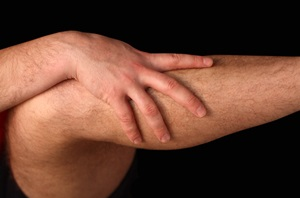 Although the term may suggest it, a shin splint is actually not a rigid device to immobilize or protect your shin. A shin splint is instead a pain in the shin caused by strenuous activity. This condition is known in medical circles as medial tibial stress syndrome (MTSS) The front of the tibia (one of the bones in the lower leg) can become inflamed due to excessive or repetitive stress being placed on the lower legs. Typically, this kind of stress includes frequent stopping and starting in sharp bursts, such as the kinds of movement common in soccer, basketball, tennis or football. Those who run frequently on hard surfaces can also be at greater risk of shin splints.
Specific sources for the kinds of impacts or pressure that can cause shin splints include the following:
The following symptoms may indicate a case of shin splints:
Whether the underlying cause is pressure or impact, the key here is "excessive". Aggressive athletes will be tempted to push "through the pain”. The problem with this strategy is that the pain from shin splints is NOT the same type of discomfort that can be produced when your body is exerting itself under the positive stress of a good workout or competition. It’s not like the “burn” or “stretch” that most athletes will be familiar with. Instead, shin splints are your body’s way of telling you that damage has been done. And that damage can actually be made worst by trying to push through it. And continuing the same level of excessive activity will likely delay recovery. Due to hormonal factors, women are at greater risk for shin splints, particularly if they have low bone density, such as that accompanying osteoporosis. Rest is the primary form of treatment for shin splints. Typically, two weeks is recommended to give the shin time to heal properly. Ice packs applied to the affected area and raising the legs can help reduce swelling and pain. Before you return to normal physical activity, check with your chiropractor to ensure your feet are structurally sound and that your spine is properly aligned. Even seemingly slight problems can change the biomechanics of walking and running, causing excessive stress on your lower legs and possibly leading to problems like plantar fasciitis and shin splints. After two weeks of rest, it should be okay to return to your regular activities. However, most physicians recommend that patients build up gradually to their prior levels of exercise or athletic activity in order to avoid setbacks in recovery. And—as always—it’s important that you be properly warmed up before engaging in strenuous activity of any kind to reduce the likelihood of injury or re-injury.
1 Comment
12/9/2022 08:00:06 am
The large bone in the front of your lower leg is called shin splints which are common in runners, dancers, and military recruits. It occurs in athletes who have recently intensified or changed their training routines.
Reply
Leave a Reply. |
AuthorPosted by Dr. Babak Missaghi Archives
August 2017
Categories
All
|

 RSS Feed
RSS Feed
